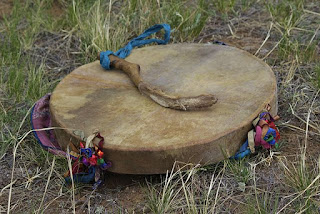In the seventh century, a major movement within Mahayana Buddhism arose. This form of Buddhism, called the Vajrayana, is most prominent in Tibet and its surrounding regions, although variations of it are found in China and Japan. The term vajra (Sanskrit: "thunderbolt vehicle," or "diamond vehicle") is used to signify the absolutely real and indestructible in a human being, as opposed to the fictions an individual entertains about himself and his nature; yana is the spiritual pursuit of the ultimately valuable and indestructible. The Vajrayana understands itself to be an esoteric form of Mahayana Buddhism with an accelerated path to enlightenment. According to the Vajrayana view, enlightenment arises from the realization that seemingly opposite principles are in truth one.
Vajrayana Buddhism includes practices that make use of mantras, mudras, mandalas and the visualization of deities and Buddhas. All ritual in Vajrayana practice can be seen as aiding in this process of visualization and identification. The practitioner can use various hand implements such as the bell, vajra (dorje), and drum (damaru), each with an elaborate symbolic meaning to create a special environment for practice. At its simplest, or most profound distillation, the bell can be said to represent "the wisdom of emptiness," the vajra embodies "compassion," while the drum -- such as damaru or Chod drums -- express "bliss." Ultimately, together they express "the compassionate wisdom of blissful emptiness."
Chod Drum: The Voice of Emptiness
Chöd is a Vajrayana practice that combines Buddhist meditation with ancient Tibetan Shamanic ritual. Chod combines the path of Enlightenment and Shamanism into one. In Chod practice, the practitioner journeys into the night world -- the dangerous regions of ghosts, spirits and the damned, to bless all souls lost for a time on the wheel of existence. The selflessness of the practitioner's compassion, his or her contact with spirits of the otherworld, and the making of himself into a vehicle of healing, provide a quick method to realize emptiness and achieve perfect enlightenment. Emptiness is the true nature of reality and the goal of all meditative practice.
The iconic symbol of Chod is the Chod drum. The Chod drum's sound, often with small bells attached to the drum, are said to be the "voice of the Dakinis (tantric deities)" and carry blessings, but also help propel the intense meditation visualization of Chod practice. The sound of the drum also reaches beyond the mundane, calling out to (or blessing) all sentient beings of all realms. When you play a drum, the sound can be heard by the spirits throughout all realms of existence. Sound is regarded as one of the most effective ways of establishing connections with other realms, since it travels through space, permeates visual and physical barriers, and conveys information from the unseen world. Sound, therefore, is a means of "relationship" as well as a "transformation" of energy.
Due to it's complexity, Chod practice generally requires a teacher and instruction to perform. Playing the drum, in any of its forms, does not, and is of immense help to meditators around the world. Using the drum for mindfulness practice does not require a teacher or extensive learning, and in fact could be considered easier to practice than meditation on the breath. Mindful drumming could not be simpler: take a good seat, focus on the beat, and when your attention wanders, return. Even one session of mindful drumming demonstrates how powerful this meditation method can be in our stressful modern lives. The powerful and compelling rhythm of the drum can still and focus the mind -- the fast path to mindfulness and well-being.





